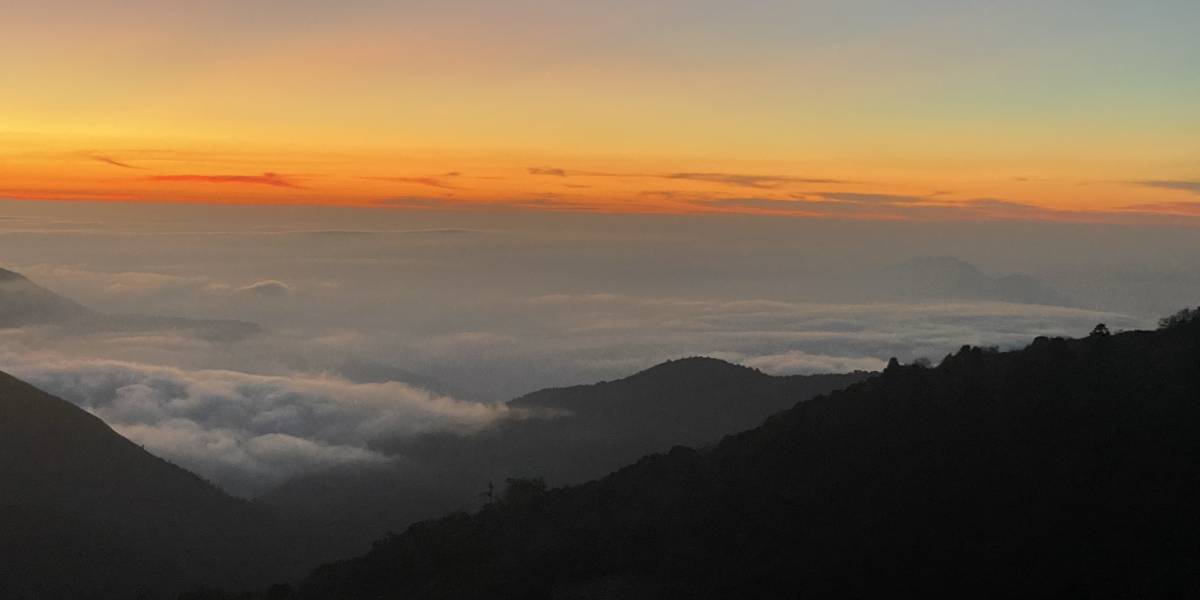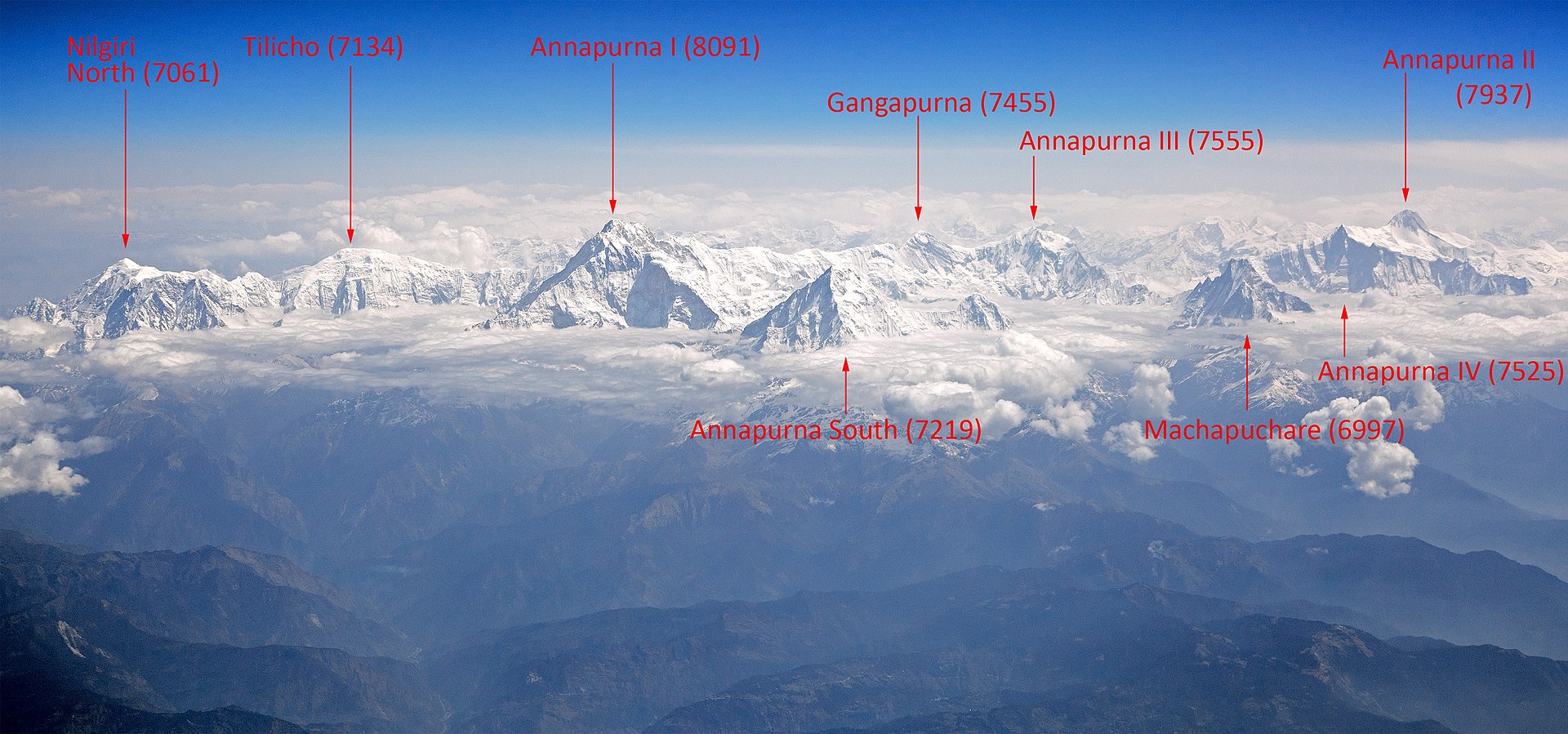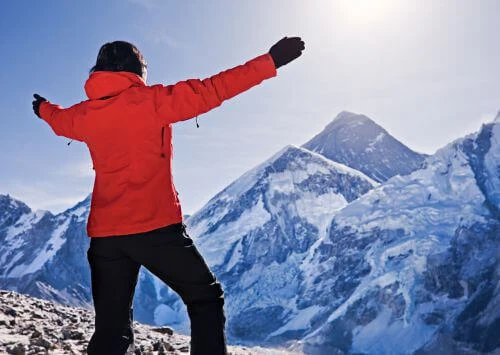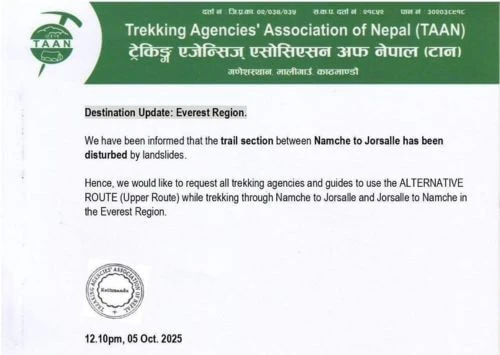Understanding the Annapurna Region and its Significance.
The Annapurna Region, located in central Nepal, is a paradise for trekkers and nature lovers. It is home to some of the highest peaks in the world, including Annapurna I, which stands at a staggering 8,091 meters. The region is also known for its rich biodiversity, with a wide range of flora and fauna. Trekking through the Annapurna Region offers a unique opportunity to experience diverse landscapes, from lush green forests to alpine meadows and snow-covered mountains. For more detail, visit our blog "History of Annapurna Base Camp Trek".
The Annapurna Base Camp Trek, in particular, takes you deep into the heart of the Annapurna Sanctuary, a natural amphitheater surrounded by towering peaks. This trek is not only a physical challenge but also a spiritual and cultural journey, as you encounter local villages, monasteries, and people with warm hospitality.
Mountains To See On The Way to Annapurna Base Camp Trek
Factors to consider when Planning the Trek.
Before deciding on the best time to embark on the Annapurna Base Camp Trek, there are several factors that you should consider. First and foremost, your fitness level and experience in high-altitude trekking play a crucial role. The Annapurna Base Camp trek is a moderate to challenging trek, with long hours of walking, steep ascents, and descents. It is essential to prepare yourself physically and mentally to ensure a safe and enjoyable experience.
Another factor to consider is your preferred level of crowd and solitude. The Annapurna Base Camp Trek is one of the most popular treks in Nepal, attracting a significant number of trekkers each year. If you prefer a quieter and less crowded experience, you may want to avoid the peak trekking seasons. However, if you enjoy meeting fellow trekkers from around the world and sharing the journey with others, then the peak seasons might be the best choice for you.

Weather Conditions and the Best Time For Annapurna Base Camp Trek.
The weather and climate in the Annapurna Region vary significantly throughout the year, making it crucial to choose the right time for your trek. Generally, the best time to embark on the Annapurna Base Camp Trek is during the Spring (March to May) and Autumn (September to November) seasons. These seasons offer the most favorable weather conditions, with stable temperatures, clear skies, and minimal chances of rain or snowfall.
Spring season: The Ideal time for the Annapurna Base Camp Trek.
Spring is considered the peak trekking season in the Annapurna Region, and for good reason. The weather during this time is mild and pleasant, with temperatures ranging from 10 to 20 degrees Celsius during the day. The skies are usually clear, offering stunning panoramic views of the surrounding mountains. The blooming rhododendron forests add a vibrant touch to the already breathtaking landscapes, creating a visual treat for trekkers. However, it is essential to note that spring is also a popular time for trekkers, so expect some crowds along the trail and in the teahouses.
Temperature Range You Can Expect on the Annapurna Base Camp Trek in Spring
Destination | Distance (km) | Elevation (m) | Day Temp (Max) | Night Temp (Min) |
Tikhedhunga | 8 km | 1,480 m | 18°C | 8°C |
Ghorepani | 12 km | 3,210 m | 15°C | 5°C |
Tadapani | 9 km | 2,630 m | 14°C | 4°C |
Chhomrong | 10 km | 2,170 m | 16°C | 6°C |
Deurali | 12 km | 3,210 m | 10°C | -1°C |
Annapurna Base Camp | 8 km | 4,130 m | 6°C | -5°C |
Autumn Season: Another great time for the Annapurna Base Camp Trek.
Autumn is another fantastic time to embark on the Annapurna Base Camp Trek. The weather during this season is stable and dry, with clear skies and comfortable temperatures. The average daytime temperature ranges from 15 to 20 degrees Celsius, making it ideal for trekking. The autumn months also offer excellent visibility, allowing trekkers to enjoy unobstructed views of the majestic mountains. The trails are generally less crowded compared to the spring season, providing a more peaceful and serene trekking experience.
Temperature Range You Can Expect on the Annapurna Base Camp Trek in Autumn
Destination | Distance (km) | Elevation (m) | Day Temp (Max) | Night Temp (Min) |
Tikhedhunga | 8 km | 1480m | 20°C | 10°C |
Ghorepani | 12 km | 3210m | 17°C | 6°C |
Tadapani | 9 km | 2,630 m | 16°C | 5°C |
Chhomrong | 10 km | 2,170 m | 18°C | 7°C |
Deurali | 12 km | 3210m | 12°C | 0°C |
Annapurna Base Camp | 8 km | 4,130 m | 8°C | -4°C |
Challenges and Considerations During the Off-Seasons.
While the spring and autumn seasons are the most popular times for the Annapurna Base Camp Trek, some trekkers prefer to undertake the adventure during the off-seasons. The off-seasons include Winter (December to February) and Monsoon (June to August). These seasons come with their own set of challenges and considerations.
Winter (December to February) – Peaceful, Cold, and Clear
During the winter months, the Annapurna Region experiences heavy snowfall, especially at higher elevations. The temperatures can drop significantly, reaching sub-zero levels. The trails may be covered in snow, making them more challenging and slippery. However, if you are an experienced trekker and enjoy the solitude of the mountains, winter can be a magical time to undertake the Annapurna Base Camp Trek. The snow-covered landscapes offer a unique and serene experience, and the views of the mountains are truly breathtaking.
Temperature Range You Can Expect on the Annapurna Base Camp Trek in Winter
Destination | Distance (km) | Elevation (m) | Day Temp (Max) | Night Temp (Min) |
Tikhedhunga | 8 km | 1,480m | 16°C | 5°C |
Ghorepani | 12 km | 3,210m | 12°C | -1°C |
Tadapani | 9 km | 2,630 m | 10°C | -2°C |
Chhomrong | 10 km | 2,170 m | 13°C | 1°C |
Deurali | 12 km | 3,210 m | 6°C | -6°C |
Annapurna Base Camp | 8 km | 4,130 m | 2°C | -10°C |
Monsoon (June to August)
The monsoon season brings heavy rainfall to the Annapurna Region, making the trails wet and muddy. Landslides and avalanches are also more common during this time. Trekking during the monsoon season can be physically demanding and risky, but it also has its advantages. The mountains come alive with lush greenery, and the waterfalls are in full flow, creating a picturesque setting. However, it is crucial to be well-prepared, both physically and mentally, and to take necessary precautions during the monsoon season.

Temperature Range You Can Expect on the Annapurna Base Camp Trek in Monsoon
Destination | Distance (km) | Elevation (m) | Day Temp (Max) | Night Temp (Min) |
Tikhedhunga | 8 km | 1,480 m | 24°C | 16°C |
Ghorepani | 12 km | 3,210 m | 22°C | 13°C |
Tadapani | 9 km | 2,630 m | 21°C | 12°C |
Chhomrong | 10 km | 2,170 m | 23°C | 14°C |
Deurali | 12 km | 3,210 m | 19°C | 9°C |
Annapurna Base Camp | 8 km | 4,130 m | 15°C | 5°C |
Which Season Fits You Best?
Choosing the right time to trek to Annapurna Base Camp really depends on what kind of experience you’re looking for. Every season brings something different to the table — from dramatic views and cultural energy to peaceful paths and budget-friendly options. Here's a quick breakdown to help you decide:
If you want the best mountain views, go in Autumn or Spring. These two seasons offer the clearest skies and sharpest Himalayan panoramas. You’ll wake up to snowcapped peaks glowing under golden morning light — the kind of views you dream of.
If you prefer quiet trails and fewer crowds, try Winter or Monsoon. While these months come with colder weather or rain, they also offer a peaceful trekking experience. You'll often have the trails and teahouses almost to yourself.
If warm temperatures matter to you, you must go in the Spring or the Monsoon. These seasons are milder. You can hike in lighter gear and enjoy longer daylight hours.
If you love flowers and lush greenery, then spring is the best time for the Annapurna Base Camp Trek.The rhododendrons are in full bloom, especially around Ghorepani and Tadapani. Forests turn into colorful wonderlands, and every turn on the trail feels like walking through a painting.
If you’re on a tight budget, consider trekking during the Monsoon. Fewer tourists mean better deals on accommodation and flights. Yes, there’s rain, but the savings and solitude can make it worth it for some trekkers.
If you’re interested in Nepal’s culture and festivals, Autumn is the season for you. Major events like Dashain and Tihar fall during this period. You’ll get to experience the rich traditions, local celebrations, and festive energy in the villages you pass through.
If you want to experince the silence and solitude in nature, Winter delivers. The trails are quiet, the mountains look even more majestic in the snow, and there's a special kind of calmness in the cold. Just be sure you are prepared for freezing nights and some icy sections on the way.
Tips for a successful Annapurna Base Camp Trek.
Regardless of the season you choose for your Annapurna Base Camp Trek, here are some essential tips to ensure a successful and enjoyable experience:
- Train and prepare: Start your physical training well in advance to build your stamina and strength. Include cardio exercises, hiking, and leg workouts in your training regimen. It is also advisable to go on shorter treks or hikes to acclimatize yourself to high-altitude conditions.
- Pack Wisely: Make sure to pack all the necessary gear and equipment for your trek. This includes warm clothing, a good pair of trekking boots, a backpack, a sleeping bag, a first aid kit, and other essentials. It is essential to pack light but also be prepared for changing weather conditions.
- Stay Hydrated: Hydration is key during the trek. Drink plenty of water and carry a water purification system or tablets to ensure a clean water supply. Avoid consuming untreated water from streams or taps.
- Listen to your body: Pay attention to any signs of altitude sickness or physical discomfort. Take it slow, and if necessary, acclimatize at lower altitudes before continuing the trek. It is essential to listen to your body and not push yourself beyond your limits.
- Respect the Environment and Local Culture: The Annapurna Region is a place of natural and cultural significance. Respect the environment by not littering and following the principles of Leave No Trace. Respect the local culture and traditions by dressing modestly and behaving respectfully towards the locals.
Read Blog:
How to Plan Your Annapurna Base Camp Trekking in Nepal
Seasonal Tips for Annapurna Base Camp Trek
Every season on the Annapurna Base Camp trek brings different weather, trail conditions, and challenges. Knowing what to pack and prepare for in each season can make your trek safer, more comfortable, and a lot more enjoyable. Whether it’s layering up in spring, staying dry in monsoon, booking early in autumn, or braving the cold in winter — these quick tips will help you plan smart and trek with confidence.
Spring (March–May)
- Wear light, layered clothing for changing temperatures.
- Mornings are chilly, but it gets warm during the day.
- A breathable fleece or jacket works well early on the trail.
Monsoon (June–August)
- Pack a good rain jacket to stay dry during daily showers.
- Wear waterproof boots to handle muddy, slippery trails.
- Bring leech socks or gaiters to avoid leech bites in the forest.
Autumn (September–November)
- Book your teahouses in advance — October gets very crowded.
- Carry a power bank; charging points may be full or limited.
- Expect dry, stable weather but busy trails.
Winter (December–February)
- You must bring heavy thermals and a warm down jacket for the cold.
- A four-season sleeping bag is essential for freezing nights.
- Pack crampons or microspikes to walk safely on icy trails.
Recommended Gear and Equipment for the ABC Trek.
Having the right gear and equipment is crucial for a successful and comfortable trek in the Annapurna Region. Here are some essential items to include in your packing list:
- Trekking Boots: Invest in a good pair of trekking boots that provide ankle support and have a sturdy sole for better grip on the trails.
- Layers of Clothing: Pack a combination of base layers, insulation layers, and outer layers to adapt to changing weather conditions. Include thermal underwear, fleece jackets, waterproof jackets, and pants.
- Sleeping Bag: Choose a sleeping bag that is suitable for cold temperatures and can provide adequate warmth and comfort during the nights.
- Backpack: Opt for a backpack that is lightweight, comfortable, and has enough space to carry all your essentials. Look for a backpack with adjustable straps and good back ventilation.
- Trekking Poles: Trekking poles can provide stability and support during steep ascents and descents. They help reduce the impact on your knees and provide balance on uneven terrain.
- Headlamp: A headlamp is essential for navigating in the dark, especially during early morning or evening treks. Make sure to carry extra batteries or a power bank.
- First Aid Kit: Prepare a basic first aid kit with essentials such as adhesive bandages, painkillers, antiseptic ointment, blister pads, and any personal medications.
Remember to pack light and only carry the essentials. It is advisable to check with your trekking agency or guide for a comprehensive packing list tailored to your specific needs.
Conclusion and Final Thoughts on the Best Time for Annapurna Base Camp Trek.
In conclusion, the Annapurna Base Camp Trek is a once-in-a-lifetime adventure that offers breathtaking views, diverse landscapes, and a chance to immerse yourself in the beauty of the Himalayas. While the best time to undertake this trek depends on various factors, the spring and autumn seasons are generally considered the most favorable. These seasons provide stable weather conditions, clear skies, and stunning views of the surrounding mountains.
However, if you are an experienced trekker and enjoy the solitude of the mountains, the off-seasons can also offer a unique and rewarding experience. Regardless of the season you choose, proper preparation, including physical training, packing the right gear, and acclimatizing to high-altitude conditions, is essential for a safe and successful trek.
So, lace up your boots, embark on this epic adventure with
Nepal Trekking Planner, and create memories that will last a lifetime in the mesmerizing
Annapurna Region of Nepal!FAQ’s
Is winter trekking dangerous?
Not really, as long as you're properly prepared. The cold can be intense, and trails might be icy in higher sections, so you’ll need the right gear like warm layers and crampons. It’s quiet and beautiful, but always check weather conditions before heading out.
What is the best month to trek to Annapurna Base Camp?
October and April are the favorites for most trekkers — the weather is stable, skies are clear, and the mountain views are absolutely breathtaking. These months offer perfect walking conditions without being too hot or too cold. Just be ready for some crowds on the trail!
Can I do the trek in the monsoon season?
Yes, you can trek during the monsoon, but you should be ready to encounter rain every day, muddy tracks, and leeches on the way. On the positive side, the scenery is great and green, and the pathway is relatively less noisy. If you don’t mind getting a little wet. It is a peaceful time to go.
Is winter trekking dangerous?
Not when you are well equipped with the appropriate winter clothes and you are experienced. Temperatures can get low and even on the trail, snow or ice will make some portions quite tricky particularly at night. And given good stride, warm gear, crampons, and some smart route-finding it is quite feasible and utterly beautiful.
Are teahouses open all year?
Not when you are well equipped with the right winter clothes and background. Temperatures are somewhat cold and may even be low at night and there is a chance of snows or ice that can make some sections of the trail tricky. However, a good plan, crampons and warm clothing make this quite possible and extremely dramatic.








